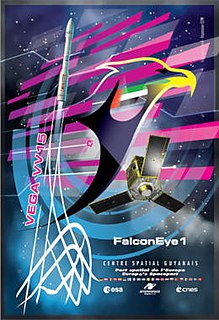
Vega, is an expendable launch system in use by Arianespace jointly developed by the Italian Space Agency (ASI) and the European Space Agency (ESA). Development began in 1998 and the first launch took place from the Centre Spatial Guyanais on 13 February 2012.
SEOSat-Ingenio, was a Spanish project to produce a satellite capable of providing wide-field imagery ensuring a repeat cycle of 38 days at 2.5 metre panchromatic resolution and 10 metre colour resolution, from a sun-synchronous polar orbit; it was Spain's first optical imaging satellite. The satellite was part of the Spanish Earth Observation Satellite program. The mission was funded by Spain's Centre for the Development of Industrial Technology (CDTI). SEOSat-Ingenio information was to be used by various Spanish civil, institutional or government users. However, under the Copernicus Programme of the European Union, it was also accessible to other European users, as well as to the Group on Earth observation of the Global Observing System of Earth.

Sentinel-2B is a European optical imaging satellite that was launched on 7 March 2017. It is the second Sentinel-2 satellite launched as part of the European Space Agency's Copernicus Programme, and its orbit will be phased 180° against Sentinel-2A. The satellite carries a wide swath high-resolution multispectral imager with 13 spectral bands. It will provide information for agriculture and forestry, among others allowing for prediction of crop yields.

Vega flight VV02 was the second flight of the Vega launcher. It occurred from the Guiana Space Centre on 7 May 2013 at 02:06:31 UTC.

Vega flight VV03 is the third flight of the Vega launcher. It occurred from the Guiana Space Centre on 30 April 2014 at 01:35:15 UTC.

Vega flight VV04 is the space launch of the IXV experimental re-entry vehicle by the 4th Vega rocket.

Vega flight VV06 is the Vega space launch of the LISA Pathfinder satellite.

Vega flight VV07 is the 7th Vega space launch, of the PerúSAT-1 and 4 SkySat satellites.

Vega flight VV15 was the 15th flight of the Vega launcher, and its first failure.

Vega flight VV08 was the launch of Göktürk-1 on board the 8th flight of the Vega launcher.

Vega flight VV09 was the launch of the Sentinel-2B satellite by the 9th Vega launcher.

Vega flight VV10 was the launch of the OPTSAT-3000 & Venµs satellites by the 10th Vega launcher.

Vega flight VV11 was the launch of the Mohammed VI-A satellite by the 11th Vega launcher.

Vega flight VV12 was the launch of the ADM-Aeolus satellite by the 12th Vega launcher.

Vega flight VV13 was the launch of the Mohammed VI-B satellite by the 13th Vega launcher.

Vega flight VV14 was the launch of the PRISMA satellite by the 14th Vega launcher.

Vega flight VV17 was the 17th launch of the Vega rocket. The rocket failed after launch and the mission was lost.

Vega flight VV18 was the 18th launch of the Vega rocket.

Vega flight VV19 was the 19th launch of the Vega rocket.



















